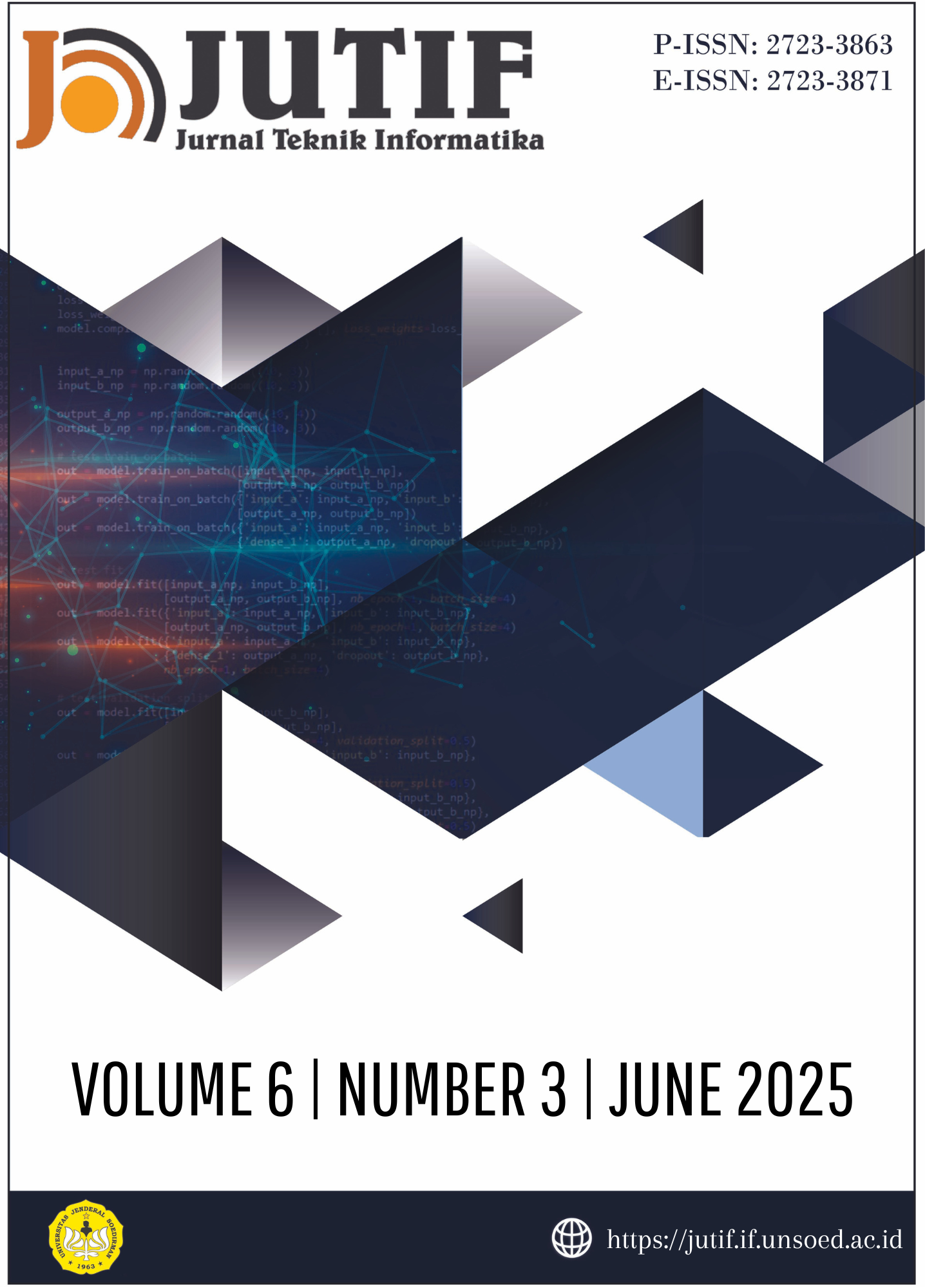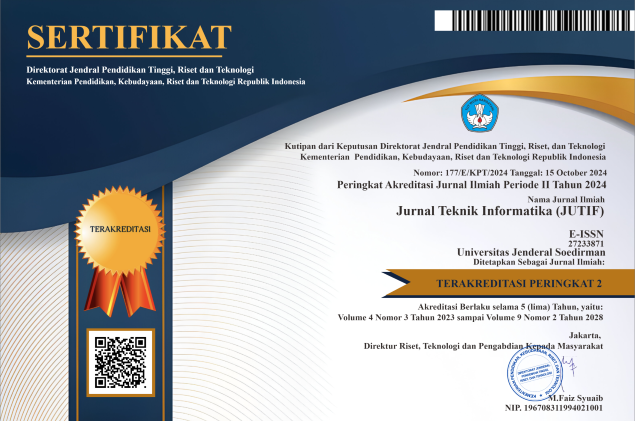Multi-Class Mangrove Classification Using Transfer Learning with MobileNet-V3 on Multi-Organ Images
DOI:
https://doi.org/10.52436/1.jutif.2025.6.3.4683Keywords:
Convolutional Neural Networks, Deep Learning, Mangrove Species, MobileNet-V3, Transfer LearningAbstract
Mangrove ecosystems are important for coastal protection, biodiversity conservation, and climate change mitigation. However, the accurate identification of mangrove species is very challenging due to the morphological similarities between different species, especially when the species are analyzed based on limited plant organs like leaves or stems. Manual identification methods have traditionally been time-consuming, error-prone, and require expert knowledge. Addressing these issues, this research suggests an automatic classification system based on Deep Learning techniques by leveraging the MobileNet-V3 architecture. The system is based on images of three different plant organs—leaves, stems, and seeds—of five mangrove species: Avicennia marina, Avicennia officinalis, Avicennia rumphiana, Rhizophora mucronata, and Sonneratia alba. Data augmentation techniques such as rotation, shifting, and flipping, as well as sharpness enhancement, were applied in the preprocessing step to enhance data variability and ease model generalization. The model was trained with a carefully selected set of hyperparameters and extensively validated through training and testing steps. The experiment results demonstrated outstanding performance with a training accuracy of 99.88% and perfect precision, recall, and F1-score values of 100%. Furthermore, testing with unseen data confirmed the robustness of the model since all test samples were correctly identified. This research concludes that the MobileNet-V3 architecture offers an effective approach to mangrove species classification and suggests that future work should involve larger and more varied datasets, real-world field environments, and the investigation of ensemble models to further extend the adaptability and scalability of mangrove monitoring systems.
Downloads
References
S. C. Das, S. Das, and J. Tah, “Mangrove Ecosystems and Their Services,” in Mangroves: Biodiversity, Livelihoods and Conservation, Singapore: Springer Nature Singapore, 2022, pp. 139–152. doi: 10.1007/978-981-19-0519-3_6.
T. Mehmood, D. Janke, G. K. Gaurav, and M. F. Sardar, “Coastal guardian: mangroves in Pakistan at risk from microplastic threats jeopardizing their crucial role in global CO2 dynamics,” Environmental Science and Pollution Research, vol. 32, no. 13, pp. 7799–7807, Mar. 2025, doi: 10.1007/s11356-025-36203-y.
M. A. Lasaiba, “Mitigation of Waste Pollution in Coastal Ecosystems and Mangrove Forests in Coastal Areas,” Jurnal Pengabdian Arumbai, vol. 2, no. 1, pp. 1–13, Feb. 2024, doi: 10.30598/arumbai.vol2.iss1.pp1-13.
K. Wang, M. Jia, X. Zhang, C. Zhao, R. Zhang, and Z. Wang, “Evaluating Ecosystem Service Value Changes in Mangrove Forests in Guangxi, China, from 2016 to 2020,” Remote Sens (Basel), vol. 16, no. 3, p. 494, Jan. 2024, doi: 10.3390/rs16030494.
Y. Wei, Y. Cheng, X. Yin, Q. Xu, J. Ke, and X. Li, “Deep Learning-Based Classification of High-Resolution Satellite Images for Mangrove Mapping,” Applied Sciences, vol. 13, no. 14, p. 8526, Jul. 2023, doi: 10.3390/app13148526.
Z. Abidin, B. Setiawan, A. W. Muhaimin, and A. Shinta, “The role of coastal biodiversity conservation on sustainability and environmental awareness in mangrove ecosystem of southern Malang, Indonesia,” Biodiversitas, vol. 22, no. 2, Jan. 2021, doi: 10.13057/biodiv/d220217.
C. Xu, J. Wang, Y. Sang, K. Li, J. Liu, and G. Yang, “An Effective Deep Learning Model for Monitoring Mangroves: A Case Study of the Indus Delta,” Remote Sens (Basel), vol. 15, no. 9, May 2023, doi: 10.3390/rs15092220.
K. Win and J. Sasaki, “The Change Detection of Mangrove Forests Using Deep Learning with Medium-Resolution Satellite Imagery: A Case Study of Wunbaik Mangrove Forest in Myanmar,” Remote Sens (Basel), vol. 16, no. 21, p. 4077, Oct. 2024, doi: 10.3390/rs16214077.
F. Farhan, C. A. Sari, E. H. Rachmawanto, and N. R. D. Cahyo, “Mangrove Tree Species Classification Based on Leaf, Stem, and Seed Characteristics Using Convolutional Neural Networks with K-Folds Cross Validation Optimalization,” Advance Sustainable Science Engineering and Technology, vol. 5, no. 3, p. 02303011, Oct. 2023, doi: 10.26877/asset.v5i3.17188.
M. Guo, Z. Yu, Y. Xu, Y. Huang, and C. Li, “Me-net: A deep convolutional neural network for extracting mangrove using sentinel-2A data,” Remote Sens (Basel), vol. 13, no. 7, Apr. 2021, doi: 10.3390/rs13071292.
C. A. Sari, P. Purwanto, E. H. Rachmawanto, and A. Syukur, “An integration of quantum systems using BB84 for enhanced security in aeroponic smart farming,” TELKOMNIKA (Telecommunication Computing Electronics and Control), vol. 22, no. 6, p. 1491, Dec. 2024, doi: 10.12928/telkomnika.v22i6.26450.
N. R. D. Cahyo and M. M. I. Al-Ghiffary, “An Image Processing Study: Image Enhancement, Image Segmentation, and Image Classification using Milkfish Freshness Images,” IJECAR) International Journal of Engineering Computing Advanced Research, vol. 1, no. 1, pp. 11–22, 2024.
I. P. Kamila, C. A. Sari, E. H. Rachmawanto, and N. R. D. Cahyo, “A Good Evaluation Based on Confusion Matrix for Lung Diseases Classification using Convolutional Neural Networks,” Advance Sustainable Science, Engineering and Technology, vol. 6, no. 1, p. 0240102, Dec. 2023, doi: 10.26877/asset.v6i1.17330.
M. M. I. Al-Ghiffary, N. R. D. Cahyo, E. H. Rachmawanto, C. Irawan, and N. Hendriyanto, “Adaptive deep learning based on FaceNet convolutional neural network for facial expression recognition,” Journal of Soft Computing, vol. 05, no. 03, pp. 271–280, 2024, doi: https://doi.org/10.52465/joscex.v5i3.450.
A. R. Nugraha et al., “Mangrove species identification using Convolutional Neural Network,” Taiwania, vol. 70, no. S, pp. 0–1, Mar. 2025, doi: 10.6165/tai.2025.70.preview.
Y. Li et al., “Comparison of Different Transfer Learning Methods for Classification of Mangrove Communities Using MCCUNet and UAV Multispectral Images,” Remote Sens (Basel), vol. 14, no. 21, p. 5533, Nov. 2022, doi: 10.3390/rs14215533.
X. Jiang and Z. Ge, “Data augmentation classifier for imbalanced fault classification,” IEEE Transactions on Automation Science and Engineering, vol. 18, no. 3, pp. 1206–1217, 2020.
F. J. Moreno-Barea, J. M. Jerez, and L. Franco, “Improving classification accuracy using data augmentation on small data sets,” Expert Syst Appl, vol. 161, p. 113696, 2020.
K. Kavin Kumar et al., “Brain Tumor Identification Using Data Augmentation and Transfer Learning Approach,” Computer Systems Science and Engineering, vol. 46, no. 2, pp. 1845–1861, 2023, doi: 10.32604/csse.2023.033927.
Q. A. Putra, C. A. Sari, E. H. Rachmawanto, N. R. D. Cahyo, E. Mulyanto, and M. A. Alkhafaji, “White Bread Mold Detection using K-Means Clustering Based on Grey Level Co-Occurrence Matrix and Region of Interest,” in 2023 International Seminar on Application for Technology of Information and Communication (iSemantic), 2023, pp. 376–381. doi: 10.1109/iSemantic59612.2023.10295369.
N. P. Sutramiani, N. Suciati, and D. Siahaan, “MAT-AGCA: Multi Augmentation Technique on small dataset for Balinese character recognition using Convolutional Neural Network,” ICT Express, vol. 7, no. 4, pp. 521–529, Dec. 2021, doi: 10.1016/j.icte.2021.04.005.
X. Yin, W. Li, Z. Li, and L. Yi, “Recognition of grape leaf diseases using MobileNetV3 and deep transfer learning,” International Journal of Agricultural and Biological Engineering, vol. 15, no. 3, pp. 184–194, 2022, doi: 10.25165/j.ijabe.20221503.7062.
H. Susanti, Zaenurrohman, M. Yusuf, and A. Sumardiono, “Simulation and Experimentation of Fire Fighting with Early Detection Based on MobileNetV2,” in 2022 5th International Seminar on Research of Information Technology and Intelligent Systems (ISRITI), IEEE, Dec. 2022, pp. 548–553. doi: 10.1109/ISRITI56927.2022.10052974.
N. R. D. Cahyo, C. A. Sari, E. H. Rachmawanto, C. Jatmoko, R. R. A. Al-Jawry, and M. A. Alkhafaji, “A Comparison of Multi Class Support Vector Machine vs Deep Convolutional Neural Network for Brain Tumor Classification,” in 2023 International Seminar on Application for Technology of Information and Communication (iSemantic), IEEE, Sep. 2023, pp. 358–363. doi: 10.1109/iSemantic59612.2023.10295336.
M. M. I. Al-Ghiffary, C. A. Sari, E. H. Rachmawanto, N. M. Yacoob, N. R. D. Cahyo, and R. R. Ali, “Milkfish Freshness Classification Using Convolutional Neural Networks Based on Resnet50 Architecture,” Advance Sustainable Science Engineering and Technology, vol. 5, no. 3, p. 0230304, Oct. 2023, doi: 10.26877/asset.v5i3.17017.
R. R. Ali et al., “Learning Architecture for Brain Tumor Classification Based on Deep Convolutional Neural Network: Classic and ResNet50,” Diagnostics, vol. 15, no. 5, p. 624, Mar. 2025, doi: 10.3390/diagnostics15050624.
S. C. Kim and Y. S. Cho, “Predictive System Implementation to Improve the Accuracy of Urine Self-Diagnosis with Smartphones: Application of a Confusion Matrix-Based Learning Model through RGB Semiquantitative Analysis,” Sensors, vol. 22, no. 14, Jul. 2022, doi: 10.3390/s22145445.
I. Markoulidakis and G. Markoulidakis, “Probabilistic Confusion Matrix: A Novel Method for Machine Learning Algorithm Generalized Performance Analysis,” Technologies (Basel), vol. 12, no. 7, p. 113, Jul. 2024, doi: 10.3390/technologies12070113.
C. Irawan, E. H. Rachmawanto, and H. P. Hadi, “An Ensemble Learning Layer for Wayang Recognition using CNN-based ResNet-50 and LSTM,” Kinetik: Game Technology, Information System, Computer Network, Computing, Electronics, and Control, 2025.
G. S. Nugraha, M. I. Darmawan, and R. Dwiyansaputra, “Comparison of CNN’s Architecture GoogleNet, AlexNet, VGG-16, Lenet -5, Resnet-50 in Arabic Handwriting Pattern Recognition,” Kinetik: Game Technology, Information System, Computer Network, Computing, Electronics, and Control, May 2023, doi: 10.22219/kinetik.v8i2.1667.
Additional Files
Published
How to Cite
Issue
Section
License
Copyright (c) 2025 Ari Sudrajat, Riri Damayanti Apnena, Ayu Hendrati Rahayu, Musab Iqtait

This work is licensed under a Creative Commons Attribution 4.0 International License.



























